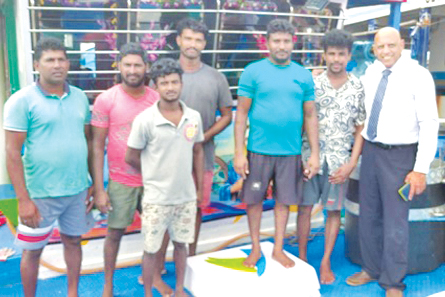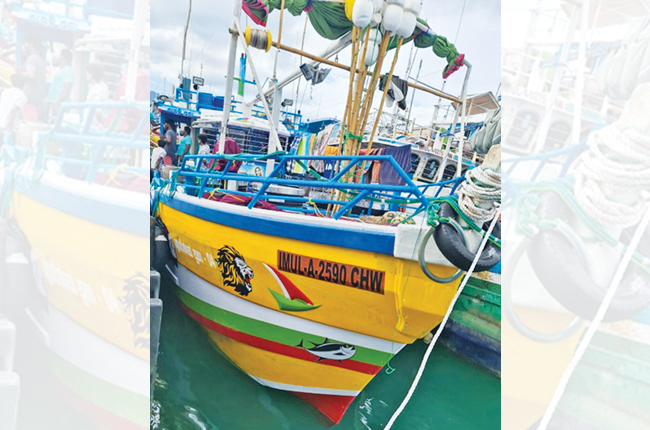- Maritime regulations, and the local boat overrun by Somalis
- How a family boat-crew ran afoul of notorious marauders of the sea.
Reflections of the moon danced gracefully on the water’s surface, creating a mesmerising play of light and shadow. But despitethe dreamlikenature of the scene, thewaves, if any, were subdued and lulled the observer into a state of tranquillity after almost two weeks at sea. The skipper had cast his nets expecting a bumper catch. He was in the right to expectgood results.
But a loud noise shattered the stillness of the night. The man now sitting in his armchair in Chilaw Sri Lanka heard it too.
 “What is that noise?” he inquired. The skipper, emerged from the bridge to find out, and was confronted with a barrage of machine gun fire, predominantly aimed skyward. Somali Pirates had caught up with the boat, its speed hindered by the deployed nets.
“What is that noise?” he inquired. The skipper, emerged from the bridge to find out, and was confronted with a barrage of machine gun fire, predominantly aimed skyward. Somali Pirates had caught up with the boat, its speed hindered by the deployed nets.
A nightmare unfolded for the skipper and the crew. The leader of the intruding gang, with continuous blows to his head, insisted that the skipper hand the satellite phone. While three of the Somaliansboarded the vessel, others were busy with another fishing boat nearby. As the pirates searched for the Satellite radio, threats and violence followed. The crew was coerced to redirect the boat towards Somalia. Another vessel, manned by a Pakistani crew, was commandeered. Meanwhile, three pirates remained onboard, while others boarded the next vessel they were preying on.
The perilous journey towards Somalia seemed inevitable. However, the skipper proved to be devious. Cunningly concealing anautomatic location communicator (ALC), and with the device providing their coordinates to shore, he manipulated connections attached to the GPS. With the aid of the magnetic compass, he steered the boat towards Seychelles. There, he anticipated the presence of patrolling coast guards who could potentially thwart the pirates’ sinister plans. Meanwhile unknown to the Somalis the ALC was sending signals to Joint Search and Recure Communication Centre (JRCC) and was tracking the Lorenzo Putha No 4’s movements.
Skilled fishermen
The Chilaw area is renowned for its rich fishing heritage, and it is home to a close-knit community of skilled fishermen. Among them are Samit, Aviska, Priyantha, and Isuru, individuals who have deep roots in the local fishing community. They have honed their fishing skills in the waters of Chilaw, contributing to the livelihood of the community through their expertise in the age-old vocation.
Kanisha, although not originally from Chilaw, hails from a nearby village. She brings her unique perspective and experiences to add to those of the crew, contributing diversity to the close-knit group. Despite the geographical difference with the rest in terms of domicile, her passion for fishing aligns seamlessly with the values of the Chilaw fishing community.
At the helm of their fishing endeavour is Dushan, the 35-year-old Skipper. He is the fourth generation in his family to dedicate their life to the fishing trade. Dushan’s grandfather navigated the traditional catamarans in the waters of Sri Lanka, passing down invaluable knowledge and skills to subsequent generations. Dushan’s father transitioned to using mechanized boats, adapting to modern developments in fishing technology while preserving the family legacy.
The crew were more than just colleagues; they were a close-knit family. Dushan’s brother-in-law was also part of the team, solidifying familial bonds on board. This created a sense of trust and understanding beyond the call of professionalism. It was crucial in negotiating the challenging and unpredictable world of fishing.
Tightly knit team
Together, this group of fishermen, with their diverse backgrounds and shared heritage, forms a resilient and tightly knit team. Their commitment to preserving traditional fishing practices embraces modern techniques and reflects the harmonious balance between heritage and progress in the Chilaw fishing community.
The atmosphere on board “Lorenzo Putha-No4” was tense needless to say, as Seychelles came in sight.The sun hung low in the sky, casting long shadows over the sea. The boys were worried. The horror stories they had heard about Somali captivity lingered in their minds.
T56 slung across his shoulder, the elder Somali leader looked menacing. His twoaccomplicessat to a side while looking stern and unforgiving. The younger boys seemed to have merely followed orders, but seemed apprehensive.
The language barrier was evident, and conversations about the $3 million ransom demanded by the pirates, and other details were lost in translation. The tension in the air was palpable, with each party wary of the other’s intentions. The crew prepared meals. The Somalis, insisted that the crew ate first, taking precautions to avoid any potential sabotage by poisoning of the meals or other means.
The rescue was unexpected and swift, catching the pirates off guard. Suddenly the loud cry “Seychelles Coast Guard!” echoed through the boat, followed by a stern command to surrender or face consequences. The Somalis had no choice but to comply, and the rest, they say, is history.
Moments of fear
Post-rescue, the three Somali pirates awaited investigation and trial in Seychelles remand. The crew members, were still onboard the vessel and unsure of the next steps.

The writer (extreme right) with the Lorenzo Putha crew.
I spent time at the Providence Fishing Harbour, sitting with the crew members and listening to their stories. Each shared their own perspective, recounting the moments of fear, uncertainty, and eventual relief. As the legal proceedings unfolded, the crew members found themselves navigating an unfamiliar terrain, wondering what lay ahead for them and the Somali pirates who had disrupted their lives.
As I stepped onto the boat at Providence Fishing Harbour, the crew members looked up, their eyes reflecting a mix of exhaustion and gratitude.
The anxieties of those onboard bore witness to a chapter of maritime drama that had unfolded unexpectedly, leaving both the victims and the perpetrators awaiting justice in the island nation of Seychelles.
PIRATES
Piracy at sea is an old vocation and it is an ancient as the other well-knownage-old profession.
Indeed, it is a notorious way of life that has evolved over the centuries, with various infamous pirates leaving their mark on maritime history. Black beard (Edward Teach or Thatch), Captain Henry Morgan, and Bartholomew Roberts (Black Bart), are just a few examples of pirates who terrorized the seas during different periods.
Captain Jack Sparrow was a fictional character, and the iconic portrayal of a pirate in the “Pirates of the Caribbean” film series, added a touch of Hollywood glamour to old pirates’ tales.
Incidents in the 1980s involving skiffs obstructing ships in the Malacca Straits highlights a historical reality where pirates, often armed with knives and operating on smaller vessels, targeted larger ships. Knife wielding gangs boarding at night, and targeting the safe in captain’s cabin were among the common tactics.
Pirate-watch was the common way to mitigate the attacks, and fully pressurised firefighting hoses was the weapon of choice for the crew.
The shift to more ambitious piracy off the coast of Somalia in the 21st century, as depicted in the movie “Captain Phillips,” marked a significant and concerning trend. Somali pirates, often heavily armed and rather sophisticated, posed a serious threat to shipping in the region.
Global maritime efforts, including naval patrols and increased security measures on ships, were implemented to combat this surge in piracy.
New Challenges
While these efforts have contributed to a reduction in pirate attacks off the coast of Somalia, new challenges, such as dealing with the Houthi insurgency in the Red Sea, demonstrate the ongoing need for a coordinated international response to ensure the safety and security of maritime routes. The maritime community continues to adapt and respond to evolving threats to maintain the integrity of global shipping.
International Regulations
International regulations on piracy are governed by various conventions and agreements. One key instrument is the United Nations Convention on the Law of the Sea (UNCLOS). Regarding the jurisdictional issues and prosecution of pirates, UNCLOS provides a legal framework for states to combat piracy and other illicit activities in the high seas.
The Case of Lorenzo Putha-No4
In an instance such as the above in which a Sri Lankan-registered ship is captured by pirates from Somalia and subsequently rescued by the Seychelles Coast Guard, several principles and international agreements would come into play. Among these are:
UNCLOS Jurisdiction: UNCLOS grants coastal states the authority to take necessary measures, including the arrest and prosecution of pirates, when piracy occurs within their territorial waters.
Piracy on the high seas falls under universal jurisdiction, meaning any state can prosecute pirates regardless of the nationality of the vessel or the victims.
Seychelles Jurisdiction: The Seychelles Coast Guard, having rescued the ship within its territorial waters, would likely have jurisdiction over the prosecution of the pirates for the acts committed within its maritime boundaries.
Sri Lankan Involvement: Sri Lanka, as the flag-state of the captured ship, may also have a role in the legal proceedings. UNCLOS recognizes the flag state’s jurisdiction over its vessels on the high seas.
International Cooperation: Resisting piracy often involves international cooperation. Countries affected by piracy often work together to combat this threat. The pirates could face prosecution in multiple jurisdictions, depending on the agreements and arrangements between the involved countries.
International Maritime Organization (IMO): The IMO, a specialized agency of the United Nations, also plays a role in coordinating efforts to combat piracy. It provides guidelines and best practices for states to follow in addressing piracy issues.
The actual legal process that would play out would depend on the specific agreements and arrangements between the involved countries. In many cases, there are bilateral or multilateral agreements, and international cooperation is crucial to ensuring effective prosecution and addressing the transnational nature of piracy. The pirates could potentially face trial in Seychelles, and Sri Lanka might collaborate with Seychelles, or take legal action on its own based on UNCLOS principles.
Priyantha Abeynayake






